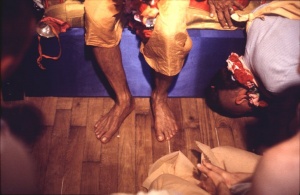CC Antya 18.97: Difference between revisions
m (1 revision(s)) |
(Vanibot #0054 edit - transform synonyms into clickable links, which search similar occurrences) |
||
| (One intermediate revision by one other user not shown) | |||
| Line 1: | Line 1: | ||
{{ | [[Category:Sri Caitanya-caritamrta - Antya-lila Chapter 18|C097]] | ||
<div style="float:left">'''[[Sri Caitanya-caritamrta|Śrī Caitanya-caritāmṛta]] - [[CC Antya|Antya-līlā]] - [[CC Antya 18|Chapter 18: Rescuing the Lord from the Sea]]'''</div> | |||
<div style="float:right">[[File:Go-previous.png|link=CC Antya 18.96|Antya-līlā 18.96]] '''[[CC Antya 18.96|Antya-līlā 18.96]] - [[CC Antya 18.98|Antya-līlā 18.98]]''' [[File:Go-next.png|link=CC Antya 18.98|Antya-līlā 18.98]]</div> | |||
{{CompareVersions|CC|Antya 18.97|CC 1975|CC 1996}} | |||
{{RandomImage}} | |||
==== TEXT 97 ==== | ==== TEXT 97 ==== | ||
<div | <div class="verse"> | ||
padmotpala—acetana, cakravāka—sacetana, | :padmotpala—acetana, cakravāka—sacetana, | ||
cakravāke padma āsvādaya | :cakravāke padma āsvādaya | ||
ihāṅ duṅhāra ulṭā sthiti, dharma haila viparīti, | :ihāṅ duṅhāra ulṭā sthiti, dharma haila viparīti, | ||
kṛṣṇera rājye aiche nyāya haya | :kṛṣṇera rājye aiche nyāya haya | ||
</div> | </div> | ||
| Line 14: | Line 18: | ||
==== SYNONYMS ==== | ==== SYNONYMS ==== | ||
<div | <div class="synonyms"> | ||
padma- | ''[//vanipedia.org/wiki/Special:VaniSearch?s=padma&tab=syno_o&ds=1 padma]-[//vanipedia.org/wiki/Special:VaniSearch?s=utpala&tab=syno_o&ds=1 utpala]'' — the blue and red lotus flowers; ''[//vanipedia.org/wiki/Special:VaniSearch?s=acetana&tab=syno_o&ds=1 acetana]'' — unconscious; ''[//vanipedia.org/wiki/Special:VaniSearch?s=cakravāka&tab=syno_o&ds=1 cakravāka]'' — the ''cakravāka'' birds; ''[//vanipedia.org/wiki/Special:VaniSearch?s=sa&tab=syno_o&ds=1 sa]-[//vanipedia.org/wiki/Special:VaniSearch?s=cetana&tab=syno_o&ds=1 cetana]'' — conscious; ''[//vanipedia.org/wiki/Special:VaniSearch?s=cakravāke&tab=syno_o&ds=1 cakravāke]'' — the ''cakravāka'' birds; ''[//vanipedia.org/wiki/Special:VaniSearch?s=padma&tab=syno_o&ds=1 padma]'' — the blue lotus flowers; ''[//vanipedia.org/wiki/Special:VaniSearch?s=āsvādaya&tab=syno_o&ds=1 āsvādaya]'' — taste; ''[//vanipedia.org/wiki/Special:VaniSearch?s=ihāṅ&tab=syno_o&ds=1 ihāṅ]'' — here; ''[//vanipedia.org/wiki/Special:VaniSearch?s=duṅhāra&tab=syno_o&ds=1 duṅhāra]'' — of both of them; ''[//vanipedia.org/wiki/Special:VaniSearch?s=ulṭā&tab=syno_o&ds=1 ulṭā] [//vanipedia.org/wiki/Special:VaniSearch?s=sthiti&tab=syno_o&ds=1 sthiti]'' — the reverse situation; ''[//vanipedia.org/wiki/Special:VaniSearch?s=dharma&tab=syno_o&ds=1 dharma]'' — characteristic nature; ''[//vanipedia.org/wiki/Special:VaniSearch?s=haila&tab=syno_o&ds=1 haila]'' — became; ''[//vanipedia.org/wiki/Special:VaniSearch?s=viparīti&tab=syno_o&ds=1 viparīti]'' — reversed; ''[//vanipedia.org/wiki/Special:VaniSearch?s=kṛṣṇera&tab=syno_o&ds=1 kṛṣṇera]'' — of Lord Kṛṣṇa; ''[//vanipedia.org/wiki/Special:VaniSearch?s=rājye&tab=syno_o&ds=1 rājye]'' — in the kingdom; ''[//vanipedia.org/wiki/Special:VaniSearch?s=aiche&tab=syno_o&ds=1 aiche]'' — such; ''[//vanipedia.org/wiki/Special:VaniSearch?s=nyāya&tab=syno_o&ds=1 nyāya]'' — principle; ''[//vanipedia.org/wiki/Special:VaniSearch?s=haya&tab=syno_o&ds=1 haya]'' — there is. | ||
</div> | </div> | ||
| Line 21: | Line 25: | ||
==== TRANSLATION ==== | ==== TRANSLATION ==== | ||
<div | <div class="translation"> | ||
"Blue and red lotus flowers are unconscious objects, whereas cakravākas are conscious and alive. Nevertheless, in ecstatic love, the blue lotuses began to taste the cakravākas. This is a reversal of their natural behavior, but in Lord Kṛṣṇa's kingdom such reversals are a principle of His pastimes. | |||
</div> | </div> | ||
| Line 28: | Line 32: | ||
==== PURPORT ==== | ==== PURPORT ==== | ||
<div | <div class="purport"> | ||
Generally the cakravāka bird tastes the lotus flower, but in | Generally the ''cakravāka'' bird tastes the lotus flower, but in Kṛṣṇa's pastimes the lotus, which is usually lifeless, tastes the ''cakravāka'' bird. | ||
</div> | </div> | ||
__NOTOC__ | |||
<div style="float:right; clear:both;">[[File:Go-previous.png|link=CC Antya 18.96|Antya-līlā 18.96]] '''[[CC Antya 18.96|Antya-līlā 18.96]] - [[CC Antya 18.98|Antya-līlā 18.98]]''' [[File:Go-next.png|link=CC Antya 18.98|Antya-līlā 18.98]]</div> | |||
__NOTOC__ | |||
__NOEDITSECTION__ | |||
Latest revision as of 20:07, 19 February 2024

A.C. Bhaktivedanta Swami Prabhupada
TEXT 97
- padmotpala—acetana, cakravāka—sacetana,
- cakravāke padma āsvādaya
- ihāṅ duṅhāra ulṭā sthiti, dharma haila viparīti,
- kṛṣṇera rājye aiche nyāya haya
SYNONYMS
padma-utpala — the blue and red lotus flowers; acetana — unconscious; cakravāka — the cakravāka birds; sa-cetana — conscious; cakravāke — the cakravāka birds; padma — the blue lotus flowers; āsvādaya — taste; ihāṅ — here; duṅhāra — of both of them; ulṭā sthiti — the reverse situation; dharma — characteristic nature; haila — became; viparīti — reversed; kṛṣṇera — of Lord Kṛṣṇa; rājye — in the kingdom; aiche — such; nyāya — principle; haya — there is.
TRANSLATION
"Blue and red lotus flowers are unconscious objects, whereas cakravākas are conscious and alive. Nevertheless, in ecstatic love, the blue lotuses began to taste the cakravākas. This is a reversal of their natural behavior, but in Lord Kṛṣṇa's kingdom such reversals are a principle of His pastimes.
PURPORT
Generally the cakravāka bird tastes the lotus flower, but in Kṛṣṇa's pastimes the lotus, which is usually lifeless, tastes the cakravāka bird.